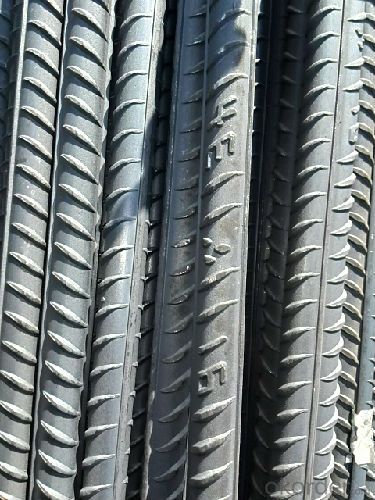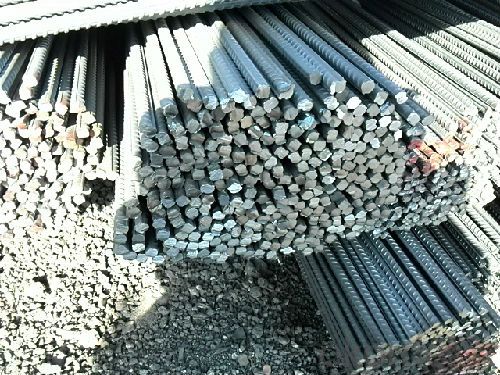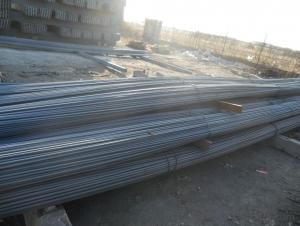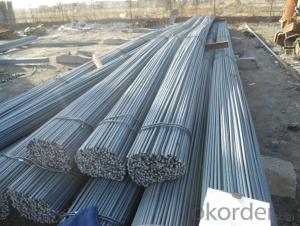Deformed steel bars type,Class IV Deformed Steel Bar with high quality
- Loading Port:
- Tianjin
- Payment Terms:
- TT or LC
- Min Order Qty:
- 50 m.t
- Supply Capability:
- 20000 m.t/month
OKorder Service Pledge
OKorder Financial Service
You Might Also Like
Product Description:
OKorder is offering Deformed steel bars type,Class IV Deformed Steel Bar with high quality at great prices with worldwide shipping. Our supplier is a world-class manufacturer of steel, with our products utilized the world over. OKorder annually supplies products to European, North American and Asian markets. We provide quotations within 24 hours of receiving an inquiry and guarantee competitive prices. We supplies a comprehensive range of standard N grade, 500 MPa deformed reinforcing bar (D500N). Length is available as your request as the reinforcing bar is often supplied processed or fabricated to suit the specific requirements of the project.
Product Applications:
Deformed steel bars type,Class IV Deformed Steel Bar with high quality are ideal for structural applications and are widely used in the construction of buildings and bridges, and the manufacturing, petrochemical, and transportation industries.
Product Advantages:
OKorder's Deformed steel bars type,Class IV Deformed Steel Bar with high quality are durable, strong, and resist corrosion.
Main Product Features:
· Premium quality
· Prompt delivery & seaworthy packing (30 days after receiving deposit)
· Corrosion resistance
· Can be recycled and reused
· Mill test certification
· Professional Service
· Competitive pricing
Product Specifications:
Manufacture: Hot rolled
Ref No. | Std Unit | Bar size mm | Length mm | Calculated metre per tonne(approx.) |
N10 | pcs | 10 | 6000 | 1582 |
N12 | pcs | 12 | 6000 | 1099 |
N16 | pcs | 16 | 6000 | 617 |
N20 | pcs | 20 | 6000 | 395 |
N24 | pcs | 24 | 6000 | 275 |
N28 | pcs | 28 | 6000 | 202 |
N32 | pcs | 32 | 6000 | 155 |
N36 | pcs | 36 | 6000 | 122 |
1 Size: From 6mm to 40mm
2 Length: 6meter, 9meter and 12meter
Package:
1: Bundle by steel strip
2: In bulk
3: Anti-water plastic woven
4: As your requirement
FAQ:
Q1: Why buy Materials & Equipment from OKorder.com?
A1: All products offered byOKorder.com are carefully selected from China's most reliable manufacturing enterprises. Through its ISO certifications, OKorder.com adheres to the highest standards and a commitment to supply chain safety and customer satisfaction.
Q2: What makes stainless steel stainless?
A2: Stainless steel must contain at least 10.5 % chromium. It is this element that reacts with the oxygen in the air to form a complex chrome-oxide surface layer that is invisible but strong enough to prevent further oxygen from "staining" (rusting) the surface. Higher levels of chromium and the addition of other alloying elements such as nickel and molybdenum enhance this surface layer and improve the corrosion resistance of the stainless material.
Q3: Can stainless steel rust?
A3: Stainless does not "rust" as you think of regular steel rusting with a red oxide on the surface that flakes off. If you see red rust it is probably due to some iron particles that have contaminated the surface of the stainless steel and it is these iron particles that are rusting. Look at the source of the rusting and see if you can remove it from the surface.
Images:


- Q:Are steel rebars susceptible to rusting?
- Yes, steel rebars are susceptible to rusting.
- Q:What is the process of handling and transporting steel rebars on-site?
- Ensuring the safe and efficient movement of steel rebars on-site involves a series of steps. To begin, the construction site receives the steel rebars, unloading them from the delivery truck and inspecting for any damage or defects. Once unloaded, the rebars are stored in a designated rebar yard, where they are arranged and stacked for easy access and protection against damage or tangling. Depending on the construction project's requirements, the rebars may be cut or bent to a specific shape before installation, utilizing specialized tools and equipment. After cutting and bending, the rebars are transported to the designated work area on the construction site. This can be done manually by workers or with the assistance of mechanical equipment like cranes or forklifts for larger quantities. In the work area, the rebars are installed according to the project's design and specifications, being placed within the appropriate positions in the concrete structure. Throughout the entire process, strict adherence to safety guidelines is crucial to prevent accidents or injuries. This includes wearing protective gear and ensuring that the rebars are handled and transported in a manner that minimizes the risk of tripping or falling. Regular inspections should also be conducted to detect any damage or defects, as these can compromise the structural integrity of the construction project.
- Q:How are steel rebars handled and installed in congested reinforcement areas?
- Steel rebars are handled and installed in congested reinforcement areas by using specialized equipment and techniques. This typically involves carefully planning and coordinating the placement of rebars to ensure they fit within the limited space available. Additionally, smaller rebars may be used, and alternative methods such as pre-fabricated cages or splicing techniques may be employed to optimize the installation process. Overall, a combination of precise planning, skilled labor, and innovative approaches is necessary to handle and install steel rebars in congested reinforcement areas.
- Q:How are steel rebars marked for identification on construction sites?
- Various methods are commonly used to mark steel rebars for identification on construction sites. The primary method involves attaching tags or labels to the rebars, which contain crucial information like the rebar's diameter, grade, length, and any necessary specifications or codes. In addition to tags, rebars can also be marked with paint or ink. This can be achieved by either spraying or stenciling the required information directly onto the rebar's surface. Paint or ink markings are typically used for temporary identification or when using tags is not feasible. Another marking method involves using colored plastic or vinyl caps on the ends of the rebars. These caps are usually color-coded to indicate different characteristics, such as rebar size or type. This allows for easy visual identification on the construction site. It's important to note that the specific method of marking rebars may vary based on local regulations, project requirements, or the preferences of the construction company or engineer. The purpose of these markings is to ensure that rebars can be easily identified and sorted during construction, promoting proper installation and adherence to design specifications.
- Q:What is the process of calculating the required quantity of steel rebars for a project?
- The process of calculating the required quantity of steel rebars for a project involves several steps. First, the engineer or designer identifies the structural elements that require reinforcement, such as beams, columns, or slabs. Next, they determine the design requirements, including the desired strength, size, and spacing of the rebars. This is typically done by referring to the project's structural drawings, codes, and specifications. Once the design requirements are known, the engineer uses mathematical formulas and calculations to determine the quantity of rebars needed. These calculations consider factors such as the dimensions of the structural elements, the load-bearing capacity required, and the specific steel reinforcement design. The engineer then takes into account any additional factors that may affect the quantity of rebars required, such as laps, overlaps, and wastage. They may also consider the practicality and availability of standard bar lengths to minimize cutting and wastage. Finally, the engineer prepares a detailed bill of quantities, which specifies the quantity, size, and type of rebars required for each structural element. This information is crucial for procurement and construction purposes, ensuring that the right amount of steel reinforcement is available for the project.
- Q:What are the advantages of using fiber-reinforced polymer (FRP) rebars over steel rebars?
- There are several advantages of using fiber-reinforced polymer (FRP) rebars over steel rebars. Firstly, FRP rebars are significantly lighter than steel rebars, making them easier to handle and transport. Additionally, FRP rebars have a higher tensile strength than steel rebars, allowing for greater flexibility in design and reducing the need for additional reinforcement. FRP rebars are also non-corrosive, unlike steel rebars which can rust over time, making them more durable and longer-lasting. Lastly, FRP rebars are non-conductive, making them suitable for use in areas with electrical or magnetic fields. Overall, the use of FRP rebars offers numerous advantages in terms of weight, strength, durability, and versatility.
- Q:What are the different methods of protecting steel rebars against corrosion?
- There are multiple methods available for safeguarding steel rebars from corrosion, which can be broadly categorized into passive and active protection. Passive protection methods involve using barrier coatings or inhibitors to prevent corrosive agents from reaching the surface of the steel rebars. One commonly used technique is applying epoxy coatings, which create a physical barrier between the rebar and its surrounding environment. These coatings can be administered through spraying, brushing, or immersion, and offer excellent corrosion protection. Another passive protection method is utilizing zinc-based coatings like galvanization or zinc-rich paints. These coatings provide sacrificial protection, where the zinc layer corrodes first, thereby shielding the steel rebar from corrosive elements. Galvanization, a widely adopted technique, involves immersing the rebar in molten zinc to form a protective layer. In addition to barrier coatings, inhibitors can also be employed to protect steel rebars. Inhibitors work by reducing the corrosive activity of the surrounding environment. Common inhibitors include calcium nitrite, which forms a protective layer on the rebar's surface, and organic compounds such as amines and phosphates, which passivate the steel and decrease corrosion rates. Active protection methods involve using impressed current cathodic protection (ICCP) or galvanic anodes. ICCP entails applying a direct electrical current to the steel rebar, counteracting the corrosive forces. This technique necessitates the installation of anodes and a power supply system. On the other hand, galvanic anodes are sacrificial metals like aluminum or magnesium that are connected to the steel rebar. The anode corrodes instead of the rebar, offering protection. It is important to consider various factors, including the environment, exposure conditions, and project requirements, when selecting a protection method. Consulting corrosion experts or engineers is often recommended to determine the most suitable method for safeguarding steel rebars from corrosion in a specific situation.
- Q:What is the purpose of using steel rebars in construction?
- The purpose of using steel rebars in construction is to increase the strength and durability of concrete structures. The rebars provide reinforcement and help resist tension forces, preventing cracks and failure in the concrete.
- Q:Can steel rebars be used in renovation or retrofitting projects?
- Yes, steel rebars can be used in renovation or retrofitting projects. Steel rebars are commonly used in construction projects to reinforce concrete structures, providing strength and durability. In renovation or retrofitting projects, where existing structures need to be strengthened or modified, steel rebars can be utilized to enhance the structural integrity and ensure the safety of the building.
- Q:What are the advantages of using steel rebars over other materials?
- There are several advantages of using steel rebars over other materials. Firstly, steel rebars have high tensile strength, making them capable of withstanding heavy loads and providing structural stability. Secondly, steel rebars are highly durable and resistant to corrosion, which ensures a longer lifespan for the reinforced concrete structures. Additionally, steel rebars are readily available and cost-effective compared to alternative materials, making them a preferred choice in construction projects. Moreover, steel rebars can be easily fabricated into various shapes and sizes, allowing for customization as per the specific structural requirements. Overall, the advantages of using steel rebars include strength, durability, corrosion resistance, affordability, and flexibility in design.
1. Manufacturer Overview |
|
|---|---|
| Location | |
| Year Established | |
| Annual Output Value | |
| Main Markets | |
| Company Certifications | |
2. Manufacturer Certificates |
|
|---|---|
| a) Certification Name | |
| Range | |
| Reference | |
| Validity Period | |
3. Manufacturer Capability |
|
|---|---|
| a)Trade Capacity | |
| Nearest Port | |
| Export Percentage | |
| No.of Employees in Trade Department | |
| Language Spoken: | |
| b)Factory Information | |
| Factory Size: | |
| No. of Production Lines | |
| Contract Manufacturing | |
| Product Price Range | |
Send your message to us
Deformed steel bars type,Class IV Deformed Steel Bar with high quality
- Loading Port:
- Tianjin
- Payment Terms:
- TT or LC
- Min Order Qty:
- 50 m.t
- Supply Capability:
- 20000 m.t/month
OKorder Service Pledge
OKorder Financial Service
Similar products
New products
Hot products
Related keywords





























